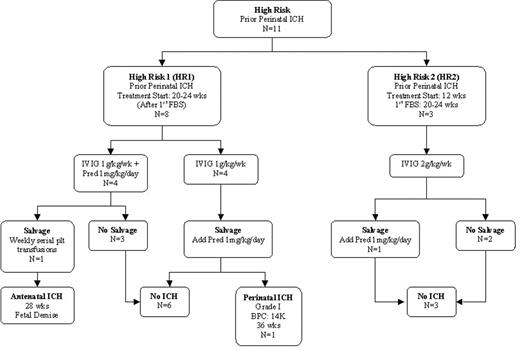Abstract
Prevention of fetal-perinatal ICH is the primary goal of antenatal therapy for AIT. When there was an ICH in a prior pregnancy, these fetuses are at virtually 100% risk for a recurrent ICH. Current antenatal treatments given to the mother are intravenous gammaglobulin (IVIG), oral steroids, or both. Two consecutive studies examined risk-based therapy by tailoring therapeutic interventions according to the course of the previous affected sibling with ICH.
Thirty patients with AIT were divided into 4 groups based on the timing of the sibling’s ICH (see Figs. 1 & 2, including abbreviations). In the Extremely High Risk (EHR), Very HR (VHR), HR1, and HR2 arms, an adequate initial response was defined as an Fetal Platelet Count (FPC) ≥30 × 109/L at the time of the first Fetal Blood Sampling (FBS). Repeat FBS was done 3–8 weeks later. If the platelet count did not increase, therapy was intensified (“salvage”) by adding prednisone or additiional IVIG. There were 5 ICHs (see Table), 3 of which were failures of antenatal therapy. One ICH occurred in an EHR patient prior to the use of 2g/kg/wk of IVIG as did one of the 2 ICHs in the HR1 study; both of these hemorrhages occurred on IVIG + pred prior to 30 weeks. Both previous siblings had had early antenatal ICHs. The second HR1 patient with ICH was initially on IVIG alone, added pred when repeat FBS was not possible because of premature contractions, and delivered at 35 weeks with a birth platelet count (BPC) of 14 × 109/L; a Grade I intraventricular ICH was noted on the first day of life. The other 2 ICHs occurred in a VHR infant delivered at 24 weeks gestation with a BPC of 248 × 109/L and in a HR2 35.7 week old infant with a BPC of 137 × 109/L. The effectiveness of the treatment strategy was demonstrated because all groups’ mean BPC was >50 × 109/L; 3 of 4 groups’ mean BPC was >100 × 109/L.
The fact that 20 of 30 of the patients required salvage therapy, and that overall, the BPC was greater than the initial FPC in all arms, attests to the need for monitoring of the FPC and for intensification of therapy in these HR patients. Comparing HR1 to HR2, starting therapy earlier than 20–24 weeks in the HR2 arm appeared to substantially increase the BPC. Antenatal therapy with IVIG 1–2g/kg/wk beginning at approximately 12 weeks gestation was effective in preventing ICH in the highest risk pregnancies in 25 of 30 cases. In the future, treatment may start with IVIG 2g/kg/wk and automatically add prednisone at 24–30 weeks for optimal response. This could also allow avoidance of FBS until at least 32 weeks.
Summary
| . | # of Patients . | # Requiring Salvage . | Mean FPC at 1st FBS (K) . | Mean Gestational Age at Birth (weeks) . | Mean BPC (K) . | # of ICHs . | # of Fetal Demises . |
|---|---|---|---|---|---|---|---|
| EHR | 4 | 3 | 23 | 32.5 | 155 | 1 | 1 |
| VHR | 15 | 11 | 74.6 | 33.6 | 122 | 2 | 0 |
| HR1 | 8 | 5 | 21.8 | 33.1 | 68.4 | 2 | 1 |
| HR2 | 3 | 1 | 54 | 33.2 | 122 | 0 | 0 |
| . | # of Patients . | # Requiring Salvage . | Mean FPC at 1st FBS (K) . | Mean Gestational Age at Birth (weeks) . | Mean BPC (K) . | # of ICHs . | # of Fetal Demises . |
|---|---|---|---|---|---|---|---|
| EHR | 4 | 3 | 23 | 32.5 | 155 | 1 | 1 |
| VHR | 15 | 11 | 74.6 | 33.6 | 122 | 2 | 0 |
| HR1 | 8 | 5 | 21.8 | 33.1 | 68.4 | 2 | 1 |
| HR2 | 3 | 1 | 54 | 33.2 | 122 | 0 | 0 |
Disclosures: Intravenous gammaglobulin for treatment of fetal alloimmune thrombocytopenia.; Grifols and IgG America have provided clinical research support.
Author notes
Corresponding author



This feature is available to Subscribers Only
Sign In or Create an Account Close Modal